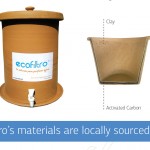Effective Use of Household Water Treatment and Safe Storage in Response to the 2010 Haiti Earthquake. American Jnl Trop Med Hyg, July 8, 2013.
Daniele Lantagne* and Thomas Clasen
When water supplies are compromised during an emergency, responders often recommend household water treatment and safe storage (HWTS) methods, such as boiling or chlorination. We evaluated the near- and longer-term impact of chlorine and filter products distributed shortly after the 2010 earthquake in Haiti. HWTS products were deemed as effective to use if they actually improved unsafe household drinking water to internationally accepted microbiological water quality standards.
The acute emergency survey (442 households) was conducted within 8 weeks of emergency onset; the recovery survey (218 households) was conducted 10 months after onset. Effective use varied by HWTS product (from 8% to 63% of recipients in the acute phase and from 0% to 46% of recipients in the recovery phase). Higher rates of effective use were associated with programs that were underway in Haiti before the emergency, had a plan at initial distribution for program continuation, and distributed products with community health worker support and a safe storage container.




